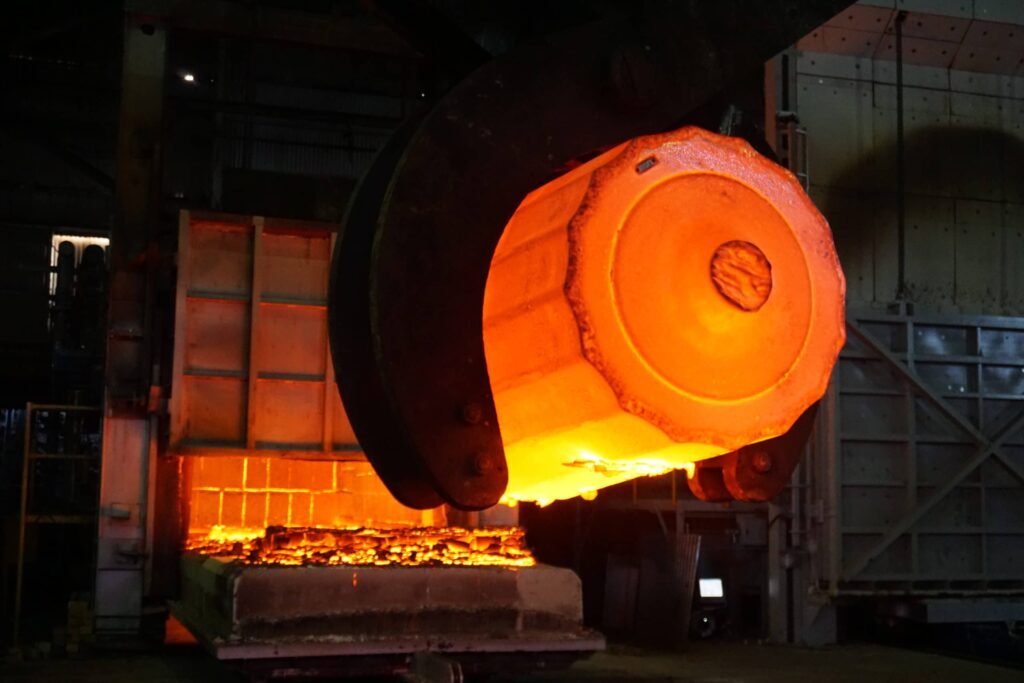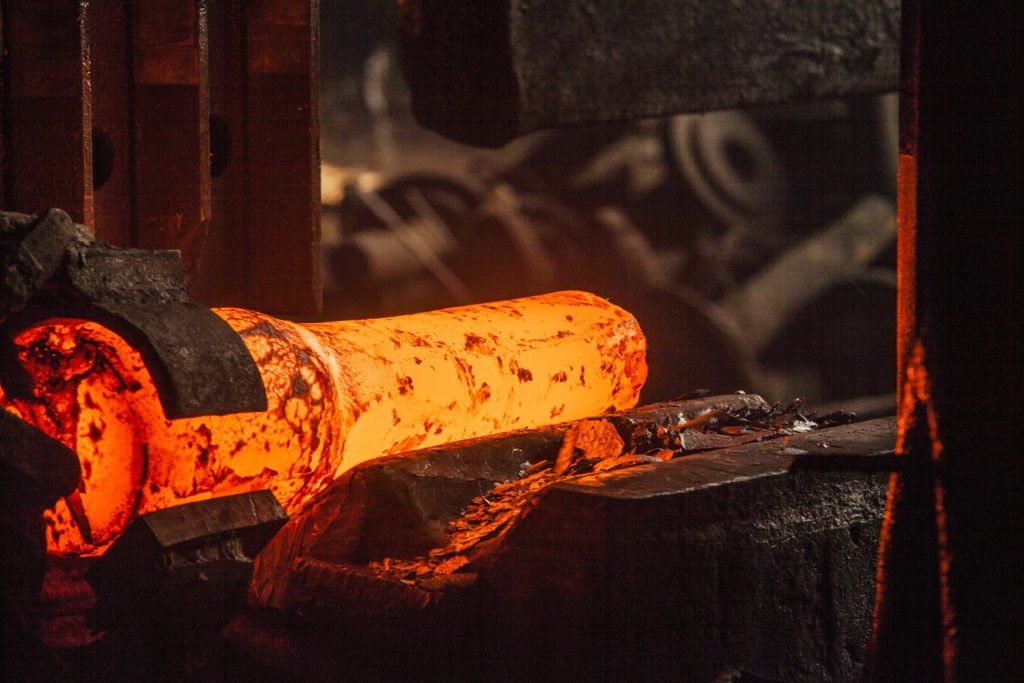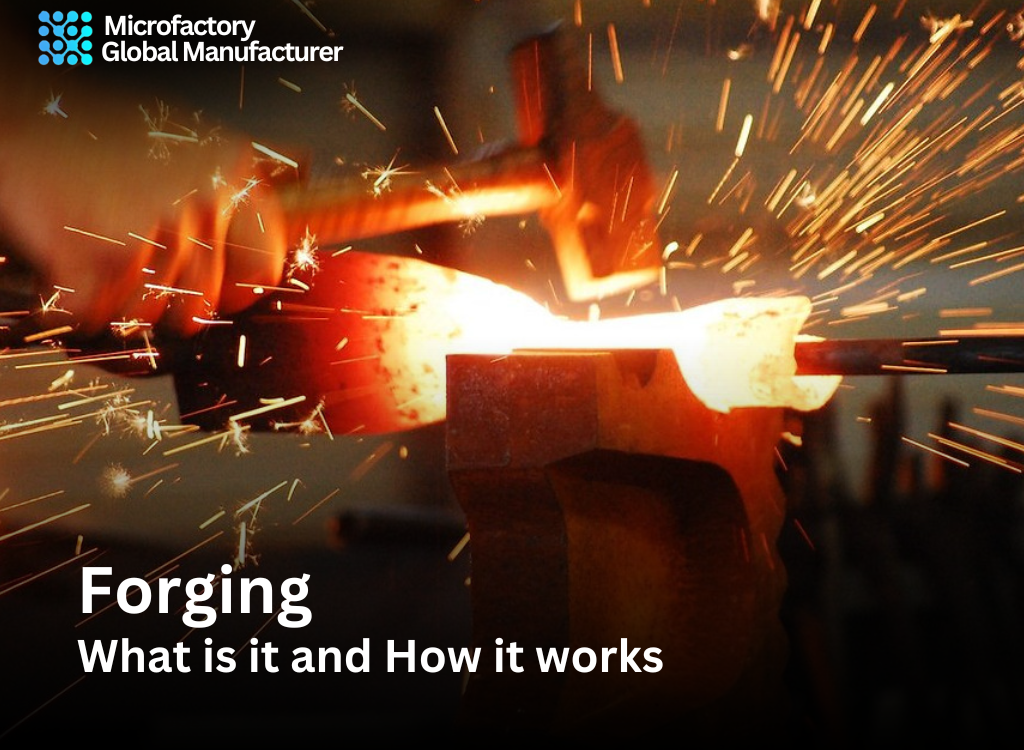These questions have echoed through the corridors of time, intriguing minds and shaping civilizations since ancient times.it is not merely a mechanical process; it’s an art form that has sculpted our history and continues to shape our present and future. From the mighty swords of medieval warriors to the precision-engineered components in modern aircraft, forging has left an indelible mark on humanity’s journey.
What is Forging?
it is a process where metal is heated and then shaped by applying compressive forces. The process involves working the metal at a temperature where it is malleable but not molten. The primary goal of it is to produce components with improved strength and mechanical properties compared to cast or machined parts.
Types of Forging
- Open-Die Forging:
- Description: Involves deforming the metal between flat or simple-shaped dies.
- Process: The metal is repeatedly hammered or pressed until it reaches the desired shape. It is often used for large, simple parts.
- Applications: Used for large components like shafts, axles, and heavy equipment parts.
- Closed-Die Forging (or Impression-Die ):
- Description: Metal is placed in a die cavity that has the shape of the desired final product.
- Process: The metal is squeezed between two dies that form the final shape of the part. It allows for more complex shapes and finer details.
- Applications: Used for smaller parts like gears, aircraft components, and automotive parts.
- Roll Forging:
- Description: Involves passing the metal through a pair of rollers that gradually shape it.
- Process: The metal is reduced in thickness and shaped as it passes through the rollers.
- Applications: Used for producing elongated parts like bars, rods, and rails.
- Upset :
- Description: Involves increasing the cross-sectional area of a metal part by compressing it axially.
- Process: The metal is compressed to increase its diameter or thickness.
- Applications: Used for creating heads on bolts and rivets.
- Precision :
- Description: A more advanced form of closed-die it that achieves high dimensional accuracy and surface finish.
- Process: Utilizes high precision dies and controlled conditions to produce parts with minimal finishing requirements.
- Applications: Used for intricate and high-precision components.
How it Works
- Heating:
- Metal Preparation: The metal is heated to a temperature where it becomes more pliable and easier to shape. This temperature is typically above the metal’s recrystallization temperature but below its melting point.
- Heating Methods: Can be done using furnaces or induction heaters.
- Shaping:
- Applying Force: The heated metal is placed in or between dies. Compressive forces are applied using hammers, presses, or rollers to shape the metal.
- Deformation: The metal is deformed in a controlled manner, either by striking with a hammer or by pressing . The goal is to shape the metal and improve its internal structure.
- Cooling:
- Controlled Cooling: After forging, the part is allowed to cool gradually. The cooling rate can affect the final properties of the metal.
- Heat Treatment: Sometimes additional heat treatment processes like annealing or quenching are applied to enhance the material properties further.
- Finishing:
- Machining and Cleaning: The forged part may require additional machining, grinding, or cleaning to achieve final dimensions and surface finish.
Advantages of Forging
- Strength: Forging improves the mechanical properties of the metal by refining its grain structure, making the part stronger and more durable.
- Reliability: Forged parts generally have fewer internal defects compared to cast parts.
- Versatility: Can produce a wide range of shapes and sizes, from simple to complex geometries.
- Reduced Waste: Often more material-efficient than some other manufacturing processes.
The Essence of Forging
At its core,it is the process of shaping metal through localized compressive forces. Unlike casting, which involves pouring molten metal into a mold, involves deforming the metal at a high temperature to achieve the desired shape. This method enhances the metal’s strength and structural integrity, making it ideal for critical applications where reliability is paramount.
Types of Forging
it encompasses a diverse range of techniques, each tailored to specific applications and requirements:
- Open-Die : Also known as smith forging, this method involves shaping metal between flat dies, allowing for greater flexibility in design and producing unique, often irregular shapes.
- Closed-Die: In contrast to open-die forging, closed-die forging utilizes dies with pre-cut impressions to precisely shape the metal into the desired form. This method yields high-precision components with tight tolerances.
- Roll Forging: Roll forging employs cylindrical rollers to gradually shape the metal into the desired profile. It is commonly used to produce long, cylindrical parts such as shafts and axles.
- Impression-Di: Also referred to as precision forging, this method involves shaping the metal within dies containing pre-designed impressions. It enables the production of complex geometries with exceptional accuracy.
Images of Forging


The Process Unveiled
Now that we’ve glimpsed the diverse tapestry of forging techniques, let’s dive deeper into the intricate process of how it works:
Step 1: Material Selection
The journey begins with the selection of the appropriate material for the desired application. Factors such as strength, ductility, and temperature resistance play a crucial role in determining the suitability of the metal for it .
Step 2: Heating
Once the material is chosen, it undergoes heating to a temperature above its recrystallization point but below its melting point. This critical phase softens the metal, making it more malleable and easier to deform.
Step 3: Shaping
With the metal at the optimal temperature, it is placed between the forging dies, and compressive forces are applied. Whether through hammer blows, hydraulic presses, or mechanical hammers, the goal is to deform the metal into the desired shape while maintaining its integrity.
Step 4: Cooling and Finishing
After shaping, the forged part undergoes controlled cooling to relieve internal stresses and enhance its mechanical properties. Depending on the application, additional processes such as machining, heat treatment, and surface finishing may be employed to achieve the desired characteristics.
The future of microfactory is set to be shaped by technological advancements and evolving manufacturing trends that emphasize flexibility, sustainability, and efficiency. which has traditionally been associated with large-scale production, is being adapted to microfactory environments where smaller, more agile, and localized manufacturing systems are becoming the norm. Here’s a look at the key trends and innovations that will define the future of microfactory:
Future of microfactory
1. Advanced Automation and Robotics
- Automated Forging Processes: Robotics and automation will play a significant role in microfactory , enabling more efficient handling of hot and processes. Robots can be used for tasks such as billet handling, die setup, and post operations, reducing human labor and increasing precision.
- AI-Driven Optimization: Machine learning and artificial intelligence (AI) can help optimize forging parameters in real time, such as temperature, force, and die alignment. This leads to higher-quality forged parts with reduced waste and material usage, a crucial factor in microfactory settings where efficiency is key.
2. Small-Batch and On-Demand Forging
- Flexible Production for Small Batches: Unlike traditional forging, which is typically focused on mass production, microfactories specialize in small-batch and custom production. New forging technologies, such as servo-driven presses, allow for rapid tooling changes and greater adaptability, making it easier to forge smaller quantities without sacrificing quality.
- On-Demand Manufacturing: Microfactories excel in just-in-time and on-demand production. it systems in these settings will need to be highly flexible and capable of producing a variety of parts quickly to respond to customer-specific needs or rapidly changing market demands.
3. Hybrid Manufacturing Approaches
- Combination of Additive Manufacturing: Forging in microfactories may increasingly be combined with additive manufacturing (3D printing) techniques. This hybrid approach can allow for greater design freedom, with complex internal structures being printed and critical load-bearing areas being forged for strength. This method enables the production of parts that are lightweight yet strong, which is important in industries like aerospace and automotive.
- Die-Less Forging: Technologies like incremental forming or other die-less processes may become more prevalent in microfactories. These methods can reduce setup costs, especially for short production runs, by eliminating the need for expensive dies.
4. Sustainable and Lightweight Materials
- Sustainable Practices: Microfactory are often designed with sustainability in mind. it processes in these environments will likely focus on reducing waste, energy consumption, and emissions. For instance, using energy-efficient induction heating methods, recycling metal scrap in-house, and integrating green energy sources can make forging more sustainable.
- Lightweight Alloys: The demand for lightweight and high-strength materials like aluminum, titanium, and magnesium alloys will grow, especially for industries like aerospace, electric vehicles, and electronics. Microfactories can cater to niche markets by producing forged parts from these advanced materials, offering a combination of lightweight and durability that is essential for high-performance applications.
5. Digitalization and Industry 4.0 Integration
- Digital Twins and Simulation: Digital twins will allow microfactories to simulate the process, optimizing part design, die configurations, and process parameters before actual production. This helps in reducing trial-and-error, shortening lead times, and minimizing material waste.
Unlocking the Mysteries of Forging
What sets forging apart from other metalworking processes? The answer lies in its transformative power:
- Enhanced Strength: By aligning the metal’s grain structure through deformation, it enhances its strength, toughness, and fatigue resistance.
- Improved Grain Structure: The controlled deformation during forging refines the metal’s grain structure, resulting in superior mechanical properties and reduced susceptibility to defects.
- Customizability: From intricate aerospace components to rugged automotive parts, offers unparalleled flexibility in design and customization, allowing engineers to unleash their creativity without compromising on performance.
Conclusion: Forging Ahead into the Future
In conclusion, it stands as a testament to humanity’s ingenuity and craftsmanship. From ancient blacksmiths hammering molten metal to modern-day engineers harnessing cutting-edge technology, the essence of forging remains unchanged: to shape raw materials into works of art that withstand the test of time. So, the next time you marvel at the sleek lines of an aircraft wing or the intricate gears of a high-performance engine, remember the timeless artistry and science behind it— where tradition meets innovation,it a path into the future!
FAQs: Decoding the Enigma of Forging
Q1: Is forging limited to ferrous metals? A1: While forging is commonly associated with ferrous metals such as steel and iron, it can also be applied to non-ferrous metals like aluminum, copper, and titanium.
Q2: What are the advantages of forging over other manufacturing processes? A2: The advantages of forging include superior strength, enhanced structural integrity, improved fatigue resistance, and the ability to produce complex shapes with tight tolerances.
Q3: Can forging be automated? A3: Yes, forging can be automated using advanced techniques such as robotic forging cells and computer-controlled hammers, enabling high-volume production with consistent quality.


